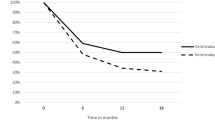Abstract
Objective
The aim of this study was to inform best evidence-based practice by collating and disseminating the experiences of members of the International Pediatric Peritoneal Dialysis Network with children having concurrent ventriculoperitoneal shunts (VPS) and peritoneal dialysis catheters (PDC).
Methods
An online questionnaire was created and distributed to all 135 centers participating in the International Pediatric Peritoneal Dialysis Network; the overall response rate was 56 %.
Results
A total of 18 patients with a concurrent VPS and PDC were reported. The children were 0–12 (mean 6.8) years old at the time of placement of the second indwelling device (PDC or VPS). In 15 cases, the PDC was inserted post-VPS. On average, the two catheters were present concurrently for 23 (range 1–60) months. There were 20 episodes of peritonitis observed in 11 of the 18 patients during a period of 392 months at risk, which is a peritonitis rate of 1/19.6 months. Only one patient developed both a VPS infection and an episode of peritonitis, and these events were temporally unrelated. No episodes of an ascending shunt infection or meningitis occurred in association with any episode of peritonitis, and no other complications of catheter dysfunction were described.
Conclusions
The rate of peritonitis, the absence of any documented ascending or descending infections and the lack of catheter dysfunction during the period of observation suggests that the presence of, or need for, a VPS should not preclude PD as a safe option for children requiring renal replacement therapy.
Similar content being viewed by others
References
Harambat J, van Stralen KJ, Kim JJ, Tizard EJ (2012) Epidemiology of chronic kidney disease in children. Pediatr Nephrol 27:363–373
Schaefer F, Warady BA (2011) Peritoneal dialysis in children with end-stage renal disease. Nat Rev Nephrol 7:659–668
Manning TC, Avellino AM, Symons J, Ojemann J, Ellenbogen RG (2008) Cerebrospinal fluid shunting in children on renal dialysis. Report of two cases. Pediatr Neurosurg 44:65–67
Kari JA (2006) Neuropathic bladder as a cause of chronic renal failure in children in developing countries. Pediatr Nephrol 21:517–520
Warady BA, Hellerstein S, Alon U (1990) Advisability of initiating chronic peritoneal dialysis in the presence of a ventriculoperitoneal shunt. Pediatr Nephrol 4:96
Kazee MR, Jackson EC, Jenkins RD (1990) Management of a child on CAPD with a ventriculoperitoneal shunt. Adv Perit Dial 6:281–282
Ram Prabahar M, Sivakumar M, Chandrasekaran V, Indhumathi E, Soundararajan P (2008) Peritoneal dialysis in a patient with neurogenic bladder and chronic kidney disease with ventriculoperitoneal shunt. Blood Purif 26:274–278
Grunberg J, Rebori A, Verocay MC (2003) Peritoneal dialysis in children with spina bifida and ventriculoperitoneal shunt: one center’s experience and review of the literature. Perit Dial Int 23:481–486
Grunberg J, Verocay MC, Rebori A, Pouso J (2007) Comparison of chronic peritoneal dialysis outcomes in children with and without spina bifida. Pediatr Nephrol 22:573–577
North American Pediatric Renal Trials and Collaborative Studies (NAPRTCS) (2011) Annual dialysis report. NAPRTCS, Boston. http://web.emmes.com/study/annlrept/annualrept2011.pdf.
Avery RA, Shah SS, Licht DJ, Seiden JA, Huh JW, Boswinkel J, Ruppe MD, Chew A, Mistry RD, Liu GT (2010) Reference range for cerebrospinal fluid opening pressure in children. N Engl J Med 363:891–893
Fischbach M, Warady BA (2009) Peritoneal dialysis prescription in children: bedside principles for optimal practice. Pediatr Nephrol 24:1633–11642
Author information
Authors and Affiliations
Corresponding author
Rights and permissions
About this article
Cite this article
Dolan, N.M., Borzych-Duzalka, D., Suarez, A. et al. Ventriculoperitoneal shunts in children on peritoneal dialysis: a survey of the International Pediatric Peritoneal Dialysis Network. Pediatr Nephrol 28, 315–319 (2013). https://doi.org/10.1007/s00467-012-2303-9
Received:
Revised:
Accepted:
Published:
Issue Date:
DOI: https://doi.org/10.1007/s00467-012-2303-9




